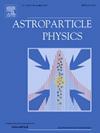用CORSIKA 8模拟粒子级联的射电发射
IF 2.9
3区 物理与天体物理
Q1 ASTRONOMY & ASTROPHYSICS
引用次数: 0
摘要
CORSIKA 8是一个新的框架,用于模拟空气和致密介质中的粒子级联,在现代c++ 17中实现,基于过去对现有代码的经验,特别是CORSIKA 7。该项目的灵活和模块化结构允许开发独立模块,可以产生完全可定制的粒子阵雨模拟。无线电模块特别设计用于以自主和灵活的方式处理电场计算及其通过复杂介质到每个观测者位置的传播。它已经允许用两种独立的时域形式计算无线电发射的同时模拟,即以前在CoREAS中实现的“端点形式”和从ZHAireS移植的“ZHS”算法。该设计作为当前和未来发展的基线接口,用于模拟粒子阵雨在标准和复杂情况下的无线电发射,例如跨介质阵雨从空气穿透到冰中。在这项工作中,我们介绍了CORSIKA 8中无线电模块的设计和实现,以及验证研究和CORSIKA 8, CORSIKA 7和ZHAireS模拟空气淋雨的无线电发射的直接比较。我们还提出了模拟细节的影响,如模拟粒子轨迹的步长对无线电发射模拟的影响,并对相同的底层空气阵雨的“端点”和“ZHS”形式进行了直接比较。最后,我们深入比较了CORSIKA 8和CORSIKA 7的最佳模拟设置,并讨论了观测差异与宇宙射线能量和质量重建工作的相关性。本文章由计算机程序翻译,如有差异,请以英文原文为准。
Simulating radio emission from particle cascades with CORSIKA 8
CORSIKA 8 is a new framework for simulations of particle cascades in air and dense media implemented in modern C++17, based on past experience with existing codes, in particular CORSIKA 7. The flexible and modular structure of the project allows the development of independent modules that can produce a fully customizable particle shower simulation. The radio module in particular is designed to treat the electric field calculation and its propagation through complex media to each observer location in an autonomous and flexible way. It already allows for the simultaneous simulation of the radio emission calculated with two independent time-domain formalisms, the “Endpoint formalism” as previously implemented in CoREAS and the “ZHS” algorithm as ported from ZHAireS. The design acts as the baseline interface for current and future development for the simulation of radio emission from particle showers in standard and complex scenarios, such as cross-media showers penetrating from air into ice. In this work, we present the design and implementation of the radio module in CORSIKA 8, along with validation studies and a direct comparison of the radio emission from air showers simulated with CORSIKA 8, CORSIKA 7, and ZHAireS. We also present the impact of simulation details such as the step size of simulated particle tracks on radio-emission simulations and perform a direct comparison of the “Endpoints” and “ZHS” formalisms for the same underlying air showers. Finally, we present an in-depth comparison of CORSIKA 8 and CORSIKA 7 for optimum simulation settings and discuss the relevance of observed differences in light of reconstruction efforts for the energy and mass of cosmic rays.
求助全文
通过发布文献求助,成功后即可免费获取论文全文。
去求助
来源期刊

Astroparticle Physics
地学天文-天文与天体物理
CiteScore
8.00
自引率
2.90%
发文量
41
审稿时长
79 days
期刊介绍:
Astroparticle Physics publishes experimental and theoretical research papers in the interacting fields of Cosmic Ray Physics, Astronomy and Astrophysics, Cosmology and Particle Physics focusing on new developments in the following areas: High-energy cosmic-ray physics and astrophysics; Particle cosmology; Particle astrophysics; Related astrophysics: supernova, AGN, cosmic abundances, dark matter etc.; Gravitational waves; High-energy, VHE and UHE gamma-ray astronomy; High- and low-energy neutrino astronomy; Instrumentation and detector developments related to the above-mentioned fields.
 求助内容:
求助内容: 应助结果提醒方式:
应助结果提醒方式:


